STORY HIGHLIGHTS
- President Jacob Zuma announces a government inquiry of the incident
- Some South Africans compare incident to apartheid-era Sharpeville massacre
- Police say they fired at the striking workers in self-defense
- 44 people were killed this week in violence at the mine -- 34 on Thursday
Are you affected by the violence? Send photos and stories to CNN iReport.
Marikana, South Africa.- The headlines Friday in South Africa spoke of a bloodbath, of war.
The morning after carnage at a platinum mine, South Africans grappled with shock, memories of an ugly era resurrected in their minds. The word apartheid surfaced again as people debated the need for such police force.
The police, meanwhile, explained themselves at a news conference, giving reporters the grim toll: 34 mine workers killed, 78 others wounded, 259 arrested on various charges, including malicious damage to property, armed robbery, illegal gathering and possession of weapons. That according to Police Commissioner Riah Phiyega.
She said police "were forced to utilize maximum force to defend themselves."
South African President Jacob Zuma cut short a trip to Mozambique to visit the scene of the shootings Friday afternoon. He announced the government will open an inquiry of the incident.
He told South Africans that they must come together to overcome national challenges as they had done before.
"This is not a day to apportion blame," Zuma said. "It is a day for us to mourn together as a nation. It is also a day to start healing."
Mourn, yes, but also a time to think about what had been done, some cried.
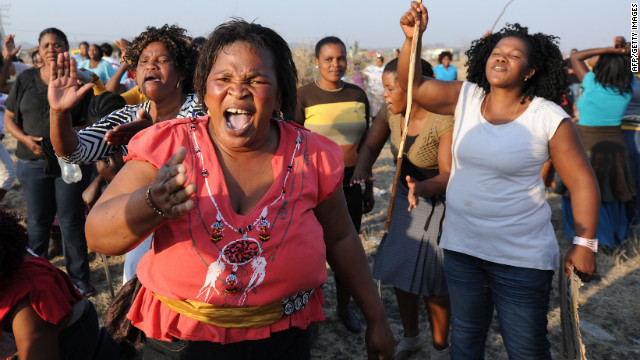 Protesters gather in Marikana, South Africa, on Friday, August 17, at the scene where 34 people died a day earlier after police opened fire on striking mineworkers. Police say they fired at the striking workers in self-defense. Marikana was one of the bloodiest incidents since the end of apartheid in 1994.
Protesters gather in Marikana, South Africa, on Friday, August 17, at the scene where 34 people died a day earlier after police opened fire on striking mineworkers. Police say they fired at the striking workers in self-defense. Marikana was one of the bloodiest incidents since the end of apartheid in 1994.
Striking South African miners armed with homemade spears and pangas chant slogans near Marikana platinum mine in Rustenburg, South Africa, on Thursday, August 16. Rising tensions at the mine exploded Thursday in grisly violence as police opened fire on striking miners.
Striking workers are monitered by police during a sit-in on a hill as they demad a wage increase.
A police vehicle takes position as miners sit on the hill.
Armed workers chant slogans outside the mine.
Workers sit together on strike.
A policeman fires at the participants of the protest.
Policemen fire at the striking miners.
A policeman gestures in front of some of the miners after they were shot. Police have not released a death toll, but a South African Press Association reporter counted 18 corpses. It is feared more could be dead.
Policemen keep watch over striking miners after they were shot.
A policeman gestures in front of some of the dead miners.
South African miners killed during strike
HIDE CAPTION
 South African miners killed during strike
South African miners killed during strike 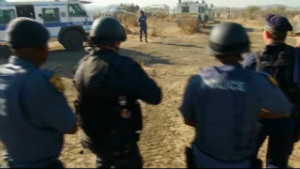 Woman's journey to find missing husband
Woman's journey to find missing husband 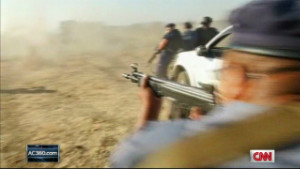 Striking miners fired on in South Africa
Striking miners fired on in South Africa 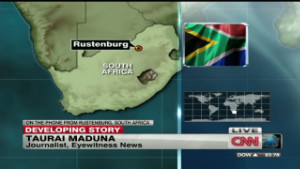 Deadly South African mine clashes
Deadly South African mine clashes  Bitter mining feud erupts in violence
Bitter mining feud erupts in violence 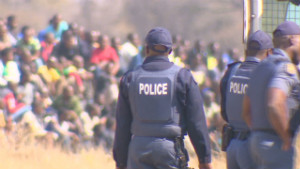 South Africa mine killings
South Africa mine killings
"African lives cheap as ever," read a headline in a Soweto newspaper.
It editorialized that South Africa's economic woes do require a war. "But a different kind of war -- a war of ideas. Not a war that dispenses with human life in as cheaply a manner as we have seen in Marikana."
The tragedy began unfolding a week ago when miners went on strike demanding pay hikes at the mine near Rustenburg, about two hours northwest of Johannesburg.
They were rock drillers who worked at the dangerous depths of the mine, their bodies vibrating for the duration of their eight-hour shifts.
"When there is a rock fall, it is generally the drillers who are the victims," wrote journalist Greg Marinovich in the Daily Maverick newspaper. "It is the most dangerous job in the business."
The miners, who earned $300 to $500 a month, wanted their salaries raised to $1,500.
It came as no surprise that their multi-national employer, Lonmin, said no to the whopping increase. The world's third-largest producer of platinum said the strike was illegal.
The larger problem, however, went beyond a wage dispute.
It had to do with a vicious rivalry between two unions -- the dominant and established National Union of Mineworkers and the splinter Association of Mineworkers and Construction Union which has been encroaching on the former's role.
The National Union of Mineworkers is a close ally of the country's ruling African National Congress. The miners, according to several South African media outlets, feel they are not adequately represented by the battling unions. They say politics gets in the way and that each union vies for miners' support and yet they don't always seek their best interests.
In January, at least three people were killed during a strike at the world's second-largest platinum mine, Impala Platinum. The violence there, too, was blamed on union rivalry.
The two unions, accused of trying to outdo each other in negotiating wages, denied instigating the clashes.
Tensions at Marikana had mounted throughout the week.
The striking miners carried traditional panga machetes and gathered Thursday around a small hill. Police carried anti-riot equipment and encircled the protesting workers.
By then, at least 10 other people were dead from incidents that had occurred in the days before. Among them were two police officers who were hacked to death.
Journalists who were at Marikana said police seemed fed up with the miners and determined to resolve the issue.
"Yesterday the police were clear that today we are going to disarm them and remove them from the hill because the gathering is illegal," said Xolile Mngambi, a reporter for CNN affiliate ETV.
By Thursday afternoon, another round of negotiations among the striking miners, the unions and Lonmin had failed.
The miners chanted war songs, witnesses said.
A heavily armed police Tactical Response Team moved in to disperse the miners.
What happened next is unclear.
To hear Phiyega, the police commissioner, describe it, the police weighed all their options and decided to fence in the miners with barbed wire -- to compartmentalize them into more manageable groups. She defended police actions, saying it was a desperate last measure against dangerous protesters.
"The armed protesters moved toward the police," she said. "They were driven back with tear gas and rubber bullets. But when they fired, police used maximum force."
But journalists at the scene could not say whether the protesters fired first.
"We cannot say to you the police were provoked," Mngambi said.
Then, the police unleashed a barrage of gunfire. One witness said it went on for three minutes.
Men dropped to the ground. Some lay motionless; others were still moving. Blood spilled onto the parched earth.
The images spread fast on the news, on the Internet. Marikana was one of the bloodiest incidents since apartheid ended in 1994.
South Africans were taken back to that time of mandated racial separation and horrific incidents of police brutality against black people. Some likened Marikana to Sharpeville, where in 1960, police fired on a crowd of black demonstrators, killing 69.
There was clear evidence, the South African Institute for Race Relations said, that policemen randomly shot into the crowd with rifles and handguns.
"There is also evidence of their continuing to shoot after a number of bodies can be seen dropping and others turning to run. This is reminiscent of the Sharpeville massacre in 1960.
"In our view," the institute said, "what happened at Lonmin is completely unacceptable. We hold no brief for the use of violence in labor or any other disputes. But even if the police were provoked or shot at during yesterday's incident, or were angry at the killing of two police officers in the days before, no disciplined and properly trained policeman would shoot into a crowd. Yesterday's incident was a disaster waiting to happen."
Marikana, said some, exposed deep-rooted problems that have been bubbling in South Africa.
"I think this us a sign of underlying structural issues which you have seen in South Africa for a long time," said Mark Rosenberg, an Africa analyst with the risk research firm Eurasia Group.
"There has been an increase in violent protests both by miners and also by citizens living in townships who are upset with the level and pace of service delivery," he said.
People are no longer willing to sit and wait around for the African National Congress to deliver.
"They are becoming more and more impatient and they're becoming more and more violent as a result," Rosenberg said.
Lonmin's chief financial officer, Simon Scott, called the situation "tragic" and expressed condolences to the family and friends of the workers and police officers who died this week. He said the company would assist with funerals and grief counseling.
Scott said Lonmin has worked for years to achieve good labor relations and said the "illegal strike we've seen is so disappointing and damaging."
"If the industry continues to be damaged by illegal actions it is not just the economy which suffers, but all our employees, their families and dependents," Scott said about South Africa's vital mining sector. "We need our employees to come back to work and we need to get mining again."
But Friday at Marikana, all was quiet. The Lonmin mine remained shut.
On the dry, dusty surrounding streets, a heavy police presence remained. And women searched desperately for husbands, fathers and brothers who did not come home.
A 9-year-old boy said he saw his father shot on television.
One of the miners, who did not want to be identified, told CNN that none of the mine workers fired at police. But regardless of whether their actions were legal or illegal, he said, none of this should have happened.
"They should not have died," he said. "All they want is a wage increase."
He said he thought South Africa was a democracy, a nation of free people. But it didn't feel that way this week at Marikana.
CNN's Nkepile Mabuse and Diane McCarthy contributed from South Africa, and Moni Basu and Faith Karimi, from Atlanta.
From around the web
MARIKANA, SOUTH AFRICA—The police killing of 34 striking platinum miners in the bloodiest security operation since the end of white rule cut to the quick of South Africa’s psyche on Friday, with searching questions asked of its post-apartheid soul.
Newspaper headlines screamed “Bloodbath,” “Killing Field” and “Mine Slaughter,” with graphic photographs of heavily armed white and black police officers walking casually past the bloodied corpses of black men lying crumpled in the dust.
The images, along with Reuters television footage of a phalanx of officers opening up with automatic weapons on a small group of men in blankets and T-shirts, rekindled uncomfortable memories of South Africa’s racist past.
Police chief Riah Phiyega confirmed 34 dead and 78 injured after officers moved in against 3,000 striking drill operators armed with machetes and sticks and massed on a rocky outcrop at the mine, 100 kilometres northwest of Johannesburg.
Phiyega, a former banking executive who was only appointed to lead the police force in June, said officers had acted in self-defence against charging, armed assailants at Lonmin’s Marikana platinum plant.
“The police members had to employ force to protect themselves from the charging group,” she told a news conference, noting that two policemen had been hacked to death by a mob at the mine on Tuesday.
However, the South African Institute of Race relations likened the incident to the 1960 Sharpeville township massacre near Johannesburg, when apartheid police opened fire on a crowd of black protesters, killing more than 50.
“Obviously the issues that have led to this are not the same as the past, but the response and the outcome is very similar,” research manager Lucy Holborn said.
In a front-page editorial, the Sowetan newspaper questioned what had changed since 1994, when Nelson Mandela overturned three centuries of white domination to become South Africa’s first black president.
“It has happened in this country before where the apartheid regime treated black people like objects,” said the paper, named after South Africa’s biggest black township. “It is continuing in a different guise now.”
South African President Jacob Zuma cut short a visit to a regional summit in neighbouring Mozambique to head to the mine. Zuma, who faces an internal leadership election in his ruling African National Congress (ANC) in December, said he was “shocked and dismayed” at the violence, but made no comment on the police behaviour.
“We believe there is enough space in our democratic order for any dispute to be resolved through dialogue without any breaches of the law or violence,” he said in a statement.
Despite promises of a better life for all South Africa’s 50 million people, the ANC has struggled to provide basic services to millions in poor black townships.
Efforts to redress the economic inequalities of apartheid have had mixed results, and the mining sector comes in for particular criticism from radical ANC factions as a bastion of “white monopoly capital.”
As dawn broke, hundreds of police patrolled the dusty plains around the Marikana mine, which was forced to shut down this week because of a rumbling union turf war that has hit the platinum sector this year.
“There were no problems overnight. The problem is the hill over there where the shooting took place. I am not sure what will happen today,” said Patience, a woman who lives in a nearby shanty town. She declined to give her full name.
Crime scene investigators combed the site of the shooting, which was cordoned off with yellow tape, collecting spent cartridges and the slain miners’ bloodstained traditional weapons — machetes and spears.
Six firearms were recovered, including a service revolver from one of the police officers killed earlier in the week.
Prior to Thursday, 10 people had died in nearly a week of conflict between rival unions at what is Lonmin’s flagship plant. The London-headquartered company has been forced to shut down all its South African platinum operations, which account for 12 per cent of global output.
South Africa is home to 80 per cent of the world’s known reserves of platinum, a precious metal used in vehicle catalytic converters. Rising power and labour costs and a steep decline this year in the price have left many mines struggling to stay afloat.
Although the striking Marikana miners were demanding huge pay hikes, the roots of the trouble lie in a challenge by the upstart Association of Mineworkers and Construction Union (AMCU) to the 25-year dominance of the National Union of Mineworkers (NUM), a close ANC ally.
“There is clearly an element in this that a key supporter of the ANC — the NUM — has come under threat from these protesting workers,” said Nic Borain, an independent political analyst.
AMCU leaders have been criticized for telling the striking miners — many of whom are barely literate — that they were “prepared to die” rather than move from their protest hill.
Pre-crackdown footage of dancing miners waving machetes and licking the blades of homemade spears raised questions about the habitual use of violence in industrial action 18 years after the end of apartheid.
“This culture of violence and protest, it must somehow be changed,” said John Robbie, a prominent Johannesburg radio host. “You can’t act like a Zulu impi in an industrial dispute in this day and age,” he said, using the Zulu word for armed units.
World platinum prices spiked nearly 3 per cent on Thursday as the full extent of the violence became clear, and rose again on Friday to a five-week high above $1,450 an ounce.
Lonmin shares in London and Johannesburg fell more than 5 per cent to four-year lows at Friday’s market open, although later trimmed their losses. Overall, they have shed nearly 15 per cent since the violence began a week ago.
Newspaper headlines screamed “Bloodbath,” “Killing Field” and “Mine Slaughter,” with graphic photographs of heavily armed white and black police officers walking casually past the bloodied corpses of black men lying crumpled in the dust.
The images, along with Reuters television footage of a phalanx of officers opening up with automatic weapons on a small group of men in blankets and T-shirts, rekindled uncomfortable memories of South Africa’s racist past.
Police chief Riah Phiyega confirmed 34 dead and 78 injured after officers moved in against 3,000 striking drill operators armed with machetes and sticks and massed on a rocky outcrop at the mine, 100 kilometres northwest of Johannesburg.
Phiyega, a former banking executive who was only appointed to lead the police force in June, said officers had acted in self-defence against charging, armed assailants at Lonmin’s Marikana platinum plant.
“The police members had to employ force to protect themselves from the charging group,” she told a news conference, noting that two policemen had been hacked to death by a mob at the mine on Tuesday.
However, the South African Institute of Race relations likened the incident to the 1960 Sharpeville township massacre near Johannesburg, when apartheid police opened fire on a crowd of black protesters, killing more than 50.
“Obviously the issues that have led to this are not the same as the past, but the response and the outcome is very similar,” research manager Lucy Holborn said.
In a front-page editorial, the Sowetan newspaper questioned what had changed since 1994, when Nelson Mandela overturned three centuries of white domination to become South Africa’s first black president.
“It has happened in this country before where the apartheid regime treated black people like objects,” said the paper, named after South Africa’s biggest black township. “It is continuing in a different guise now.”
South African President Jacob Zuma cut short a visit to a regional summit in neighbouring Mozambique to head to the mine. Zuma, who faces an internal leadership election in his ruling African National Congress (ANC) in December, said he was “shocked and dismayed” at the violence, but made no comment on the police behaviour.
“We believe there is enough space in our democratic order for any dispute to be resolved through dialogue without any breaches of the law or violence,” he said in a statement.
Despite promises of a better life for all South Africa’s 50 million people, the ANC has struggled to provide basic services to millions in poor black townships.
Efforts to redress the economic inequalities of apartheid have had mixed results, and the mining sector comes in for particular criticism from radical ANC factions as a bastion of “white monopoly capital.”
As dawn broke, hundreds of police patrolled the dusty plains around the Marikana mine, which was forced to shut down this week because of a rumbling union turf war that has hit the platinum sector this year.
“There were no problems overnight. The problem is the hill over there where the shooting took place. I am not sure what will happen today,” said Patience, a woman who lives in a nearby shanty town. She declined to give her full name.
Crime scene investigators combed the site of the shooting, which was cordoned off with yellow tape, collecting spent cartridges and the slain miners’ bloodstained traditional weapons — machetes and spears.
Six firearms were recovered, including a service revolver from one of the police officers killed earlier in the week.
Prior to Thursday, 10 people had died in nearly a week of conflict between rival unions at what is Lonmin’s flagship plant. The London-headquartered company has been forced to shut down all its South African platinum operations, which account for 12 per cent of global output.
South Africa is home to 80 per cent of the world’s known reserves of platinum, a precious metal used in vehicle catalytic converters. Rising power and labour costs and a steep decline this year in the price have left many mines struggling to stay afloat.
Although the striking Marikana miners were demanding huge pay hikes, the roots of the trouble lie in a challenge by the upstart Association of Mineworkers and Construction Union (AMCU) to the 25-year dominance of the National Union of Mineworkers (NUM), a close ANC ally.
“There is clearly an element in this that a key supporter of the ANC — the NUM — has come under threat from these protesting workers,” said Nic Borain, an independent political analyst.
AMCU leaders have been criticized for telling the striking miners — many of whom are barely literate — that they were “prepared to die” rather than move from their protest hill.
Pre-crackdown footage of dancing miners waving machetes and licking the blades of homemade spears raised questions about the habitual use of violence in industrial action 18 years after the end of apartheid.
“This culture of violence and protest, it must somehow be changed,” said John Robbie, a prominent Johannesburg radio host. “You can’t act like a Zulu impi in an industrial dispute in this day and age,” he said, using the Zulu word for armed units.
World platinum prices spiked nearly 3 per cent on Thursday as the full extent of the violence became clear, and rose again on Friday to a five-week high above $1,450 an ounce.
Lonmin shares in London and Johannesburg fell more than 5 per cent to four-year lows at Friday’s market open, although later trimmed their losses. Overall, they have shed nearly 15 per cent since the violence began a week ago.
Top Stories on the Web:
















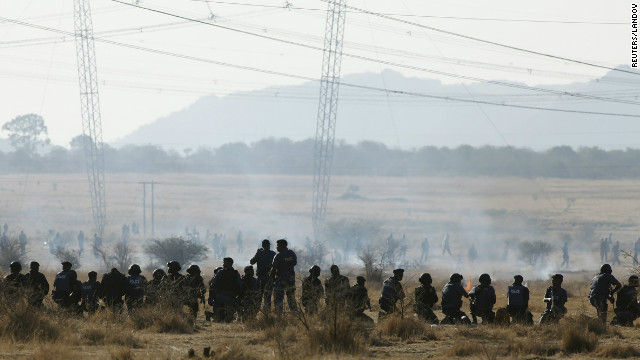
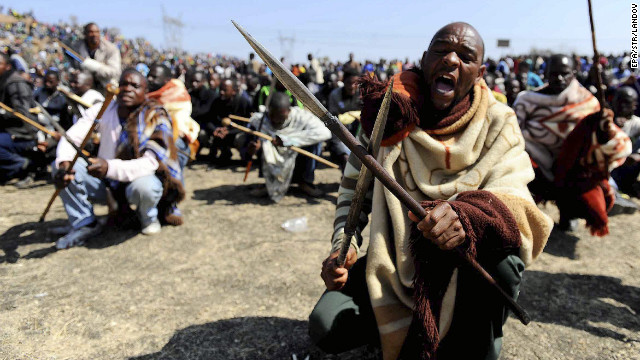 Striking South African miners armed with homemade spears and pangas chant slogans near Marikana platinum mine in Rustenburg, South Africa, on Thursday, August 16. Rising tensions at the mine exploded Thursday in grisly violence as police opened fire on striking miners.
Striking South African miners armed with homemade spears and pangas chant slogans near Marikana platinum mine in Rustenburg, South Africa, on Thursday, August 16. Rising tensions at the mine exploded Thursday in grisly violence as police opened fire on striking miners. 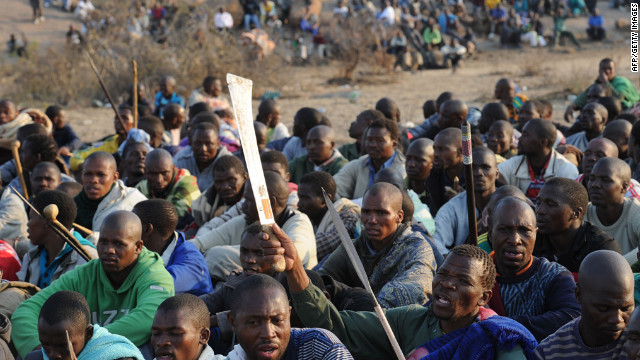 Striking workers are monitered by police during a sit-in on a hill as they demad a wage increase.
Striking workers are monitered by police during a sit-in on a hill as they demad a wage increase. 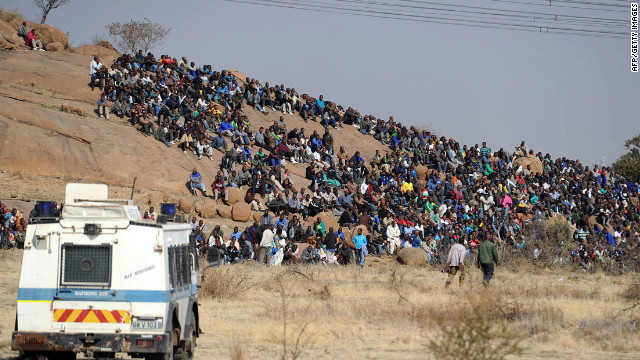 A police vehicle takes position as miners sit on the hill.
A police vehicle takes position as miners sit on the hill. 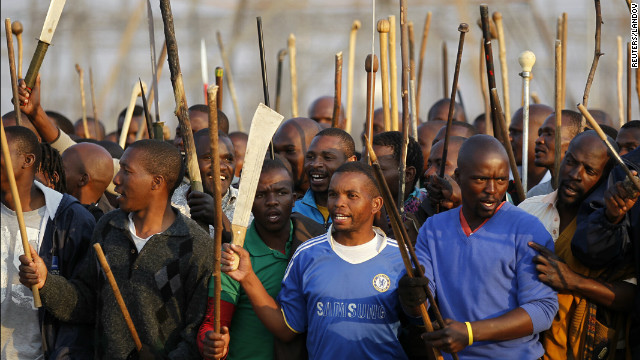 Armed workers chant slogans outside the mine.
Armed workers chant slogans outside the mine. 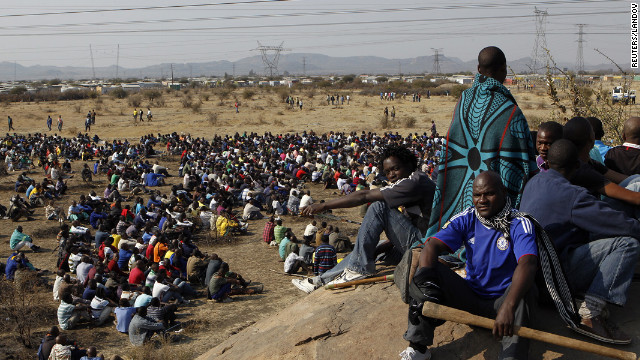 Workers sit together on strike.
Workers sit together on strike. 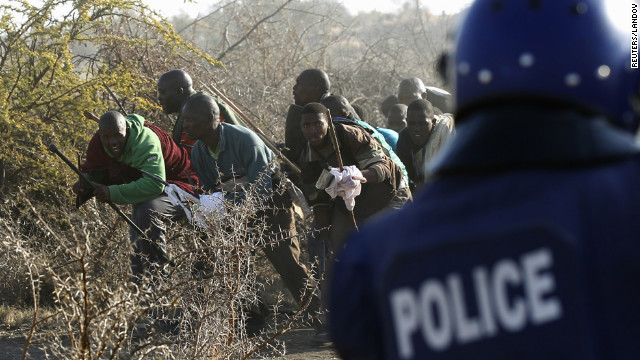 A policeman fires at the participants of the protest.
A policeman fires at the participants of the protest. 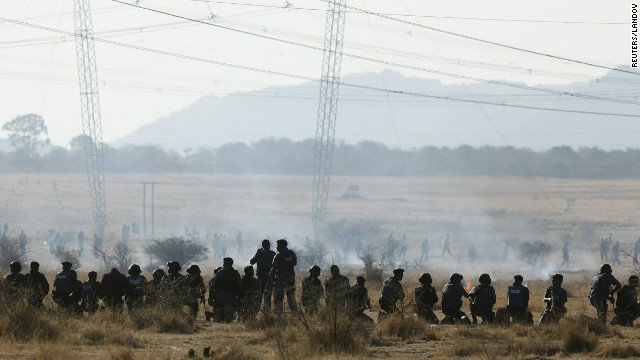 Policemen fire at the striking miners.
Policemen fire at the striking miners. 
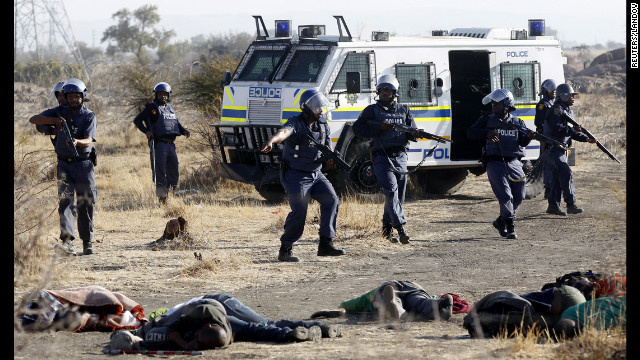 A policeman gestures in front of some of the miners after they were shot. Police have not released a death toll, but a South African Press Association reporter counted 18 corpses. It is feared more could be dead.
A policeman gestures in front of some of the miners after they were shot. Police have not released a death toll, but a South African Press Association reporter counted 18 corpses. It is feared more could be dead. 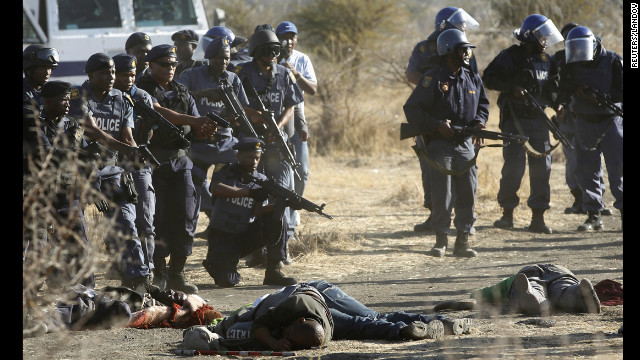 Policemen keep watch over striking miners after they were shot.
Policemen keep watch over striking miners after they were shot.  A policeman gestures in front of some of the dead miners.
A policeman gestures in front of some of the dead miners. 












No comments:
Post a Comment